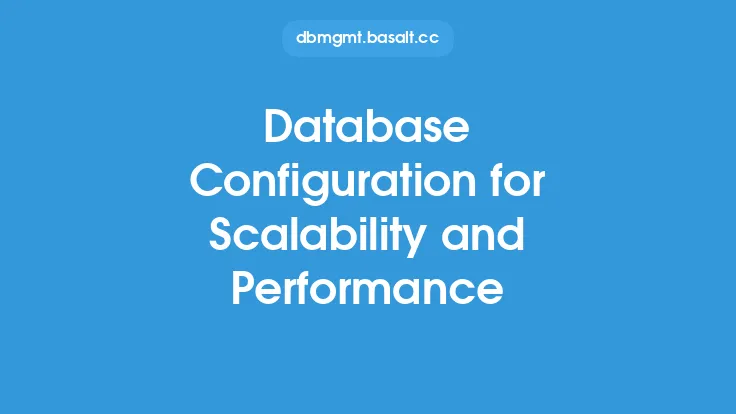When designing a database, one of the primary concerns is ensuring that it can scale to meet the needs of a growing application or user base, while also maintaining optimal performance. This is where database design patterns come into play. A well-designed database can make all the difference in ensuring that an application remains responsive and efficient, even under heavy loads. In this article, we will explore some of the most effective database design patterns for scalability and performance.
Introduction to Database Design Patterns
Database design patterns are reusable solutions to common database design problems. They provide a proven development paradigm to help designers and developers create databases that are scalable, maintainable, and efficient. By using established design patterns, developers can avoid common pitfalls and ensure that their database is optimized for performance and scalability from the outset. Some common database design patterns include the use of indexes, partitioning, and data replication.
Normalization and Denormalization
Normalization and denormalization are two fundamental database design patterns that can have a significant impact on scalability and performance. Normalization involves organizing data into tables to minimize data redundancy and improve data integrity. This can help to reduce storage requirements and improve query performance. However, over-normalization can lead to increased join complexity, which can negatively impact performance. Denormalization, on the other hand, involves intentionally duplicating data to improve query performance. This can be useful in read-heavy workloads, but can lead to data inconsistencies and increased storage requirements.
Indexing and Query Optimization
Indexing is a critical database design pattern that can significantly improve query performance. An index is a data structure that improves the speed of data retrieval by providing a quick way to locate specific data. There are several types of indexes, including B-tree indexes, hash indexes, and full-text indexes. By carefully selecting the right type of index and indexing strategy, developers can improve query performance and reduce the load on the database. Additionally, query optimization techniques such as caching, materialized views, and query rewriting can also help to improve performance.
Data Partitioning and Sharding
Data partitioning and sharding are database design patterns that involve dividing large datasets into smaller, more manageable pieces. Partitioning involves dividing a table into smaller pieces based on a specific criteria, such as date or region. Sharding involves dividing a dataset across multiple servers, each of which contains a portion of the overall data. Both partitioning and sharding can help to improve query performance and reduce storage requirements. However, they can also add complexity to the database design and require additional maintenance.
Data Replication and Caching
Data replication and caching are database design patterns that involve duplicating data to improve performance and availability. Replication involves maintaining multiple copies of data in different locations, which can help to improve availability and reduce latency. Caching involves storing frequently accessed data in a faster, more accessible location, which can help to improve query performance. Both replication and caching can help to improve performance and availability, but can also add complexity to the database design and require additional maintenance.
Distributed Database Design
Distributed database design is a database design pattern that involves spreading data across multiple servers, each of which contains a portion of the overall data. This can help to improve scalability and performance, as well as provide improved availability and fault tolerance. However, distributed database design can also add complexity to the database design and require additional maintenance. Some common distributed database design patterns include master-slave replication, peer-to-peer replication, and distributed hash tables.
NoSQL Database Design Patterns
NoSQL databases are designed to handle large amounts of unstructured or semi-structured data and provide high scalability and performance. Some common NoSQL database design patterns include key-value stores, document-oriented databases, and graph databases. NoSQL databases often use a variety of techniques to improve performance and scalability, including data replication, caching, and distributed query processing. However, NoSQL databases can also have limitations, such as lack of support for transactions and limited query capabilities.
Cloud-Based Database Design
Cloud-based database design is a database design pattern that involves hosting a database in the cloud, rather than on-premises. This can provide a number of benefits, including improved scalability and performance, as well as reduced maintenance and costs. Cloud-based databases can also provide improved availability and fault tolerance, as well as support for big data and analytics workloads. However, cloud-based databases can also have limitations, such as limited control over infrastructure and potential security risks.
Best Practices for Database Design
When designing a database, there are several best practices to keep in mind. First, it's essential to understand the requirements of the application and the characteristics of the data. This includes understanding the data model, the query patterns, and the performance requirements. Second, it's essential to choose the right database management system and data storage technology. This includes considering factors such as scalability, performance, and support for transactions and querying. Finally, it's essential to monitor and maintain the database, including performing regular backups, updates, and performance tuning.
Conclusion
Database design patterns are essential for ensuring that a database is scalable, maintainable, and efficient. By using established design patterns, developers can avoid common pitfalls and ensure that their database is optimized for performance and scalability from the outset. Some common database design patterns include normalization and denormalization, indexing and query optimization, data partitioning and sharding, data replication and caching, distributed database design, NoSQL database design patterns, and cloud-based database design. By following best practices and using the right design patterns, developers can create databases that are optimized for performance and scalability, and that can meet the needs of a growing application or user base.





